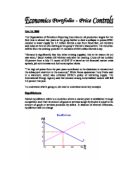Second degree price discrimination occurs when the seller charges a different price according to the volume or quantity a consumer buys. What is more important in this case is the correct perception of a consumer group’s ability and willingness to pay. Sellers in telecommunications, railways, highways, water, power service providers and fuels charge prices that vary according to consumer category.
Third degree price discrimination applies when sellers’ prices vary according to the market where the output gets sold. As with the second type, the information sellers need is relatively lighter as compared to the first type. A seller simply needs to correctly assess each market’s ability and willingness to pay. Provincial transportation service providers usually charge different fares from those in Manila, which are not a result of variable costs, distance or passenger volumes. So do international and domestic airlines, international shippers and domestic ferry services.
The primary objective of most price discriminating sellers is to increase profits. Two aspects of the practice should be emphasized. The first is the price variability of the same output, not the higher prices. Second, the price variability cannot be attributed to quality or difference in cost. But before a seller can impose price discrimination, three conditions need to be present. The most important, as already mentioned, is that a seller has information regarding consumers’ or markets’ ability and willingness to pay; which needs to be more detailed in the first type than in the other two. He needs this because he will be imposing a different price for what is essentially the same output and so needs to correctly identify which consumer or market is able and willing to pay the higher price.
The second condition is price inelasticity of demand for the output; in other words, quantity of demand for the product should not change as much as the change in price goes up or down. If demand were price elastic, a higher price would cause buyers to buy less, and profits to fall. The third condition is that no market for reselling the output should exist. A market for re-sale or second-hand output would allow previous buyers to take advantage of the discriminating sellers’ pricing policy. In all the market examples cited here, all three considerations are met.
Whether price discrimination is for profit maximisation or other reasons, it redistributes well-being or benefit in the market. The logic adapted here is that market agents derive benefits from market participation. One aspect of this redistribution is the additional profits reaped by a price-discriminating seller. These additional profits derive entirely from the higher prices that some consumers pay. Stated in another way, there is a reduction or loss in consumer well- being. The amount of consumer(s) losses (or the gain in sellers’ well-being) depends mainly on the type of price discrimination applied and the price inelasticity of demand.
On the other hand, a seller can justify price discrimination by claiming that the higher prices charged to certain consumers serve to compensate for the lower prices paid by others -- the price discrimination is actually a cross-subsidy scheme. A further validation of this claim can be made in industries which are vital and necessary, but in which certain services would cease to exist if not for this cross subsidisation. (An airline can claim, for instance, that unprofitable flights to economically backward provinces are kept alive by its more lucrative routes.). But a claim in this regard should be checked against several premises. First, the consumers who benefit should deserve the subsidy, based on characteristics (e.g. economically disadvantaged) that society finds acceptable. Second, the additional consumption of the output should not represent any form of waste or misuse.
Lastly, as in any situation where the seller acts to reallocate resources, care should be taken (possibly through government regulation) that resources actually end up with intended recipients.








